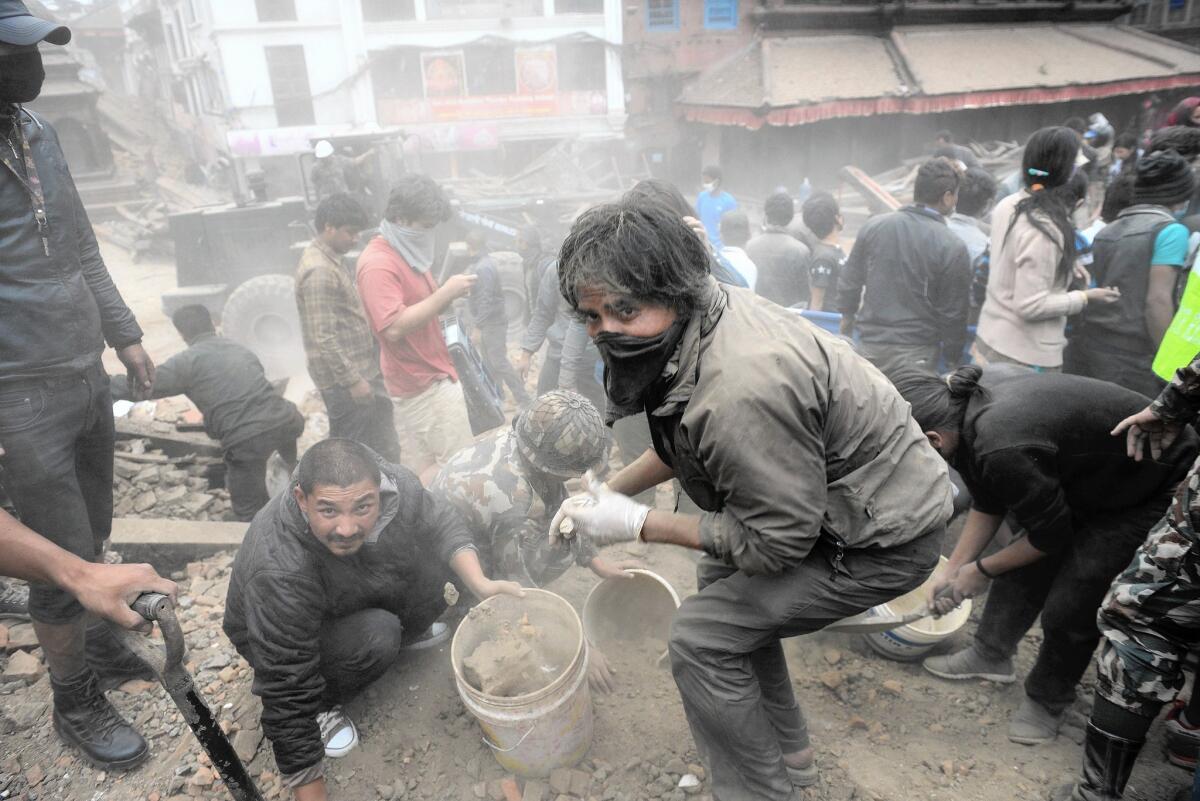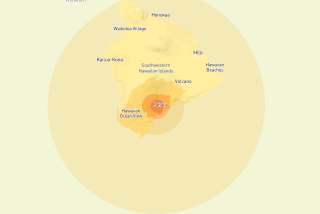Katmandu’s poorly constructed buildings worsen quake outcome

An exploding urban population that led to taller and often poorly constructed buildings, along with an unusually hazardous combination of geological conditions, had for years prompted warnings from scientists that the Katmandu Valley of Nepal was a seismic time bomb waiting to go off.
Saturday morning, it did.
The magnitude 7.8 earthquake and a magnitude 6.6 aftershock toppled buildings, set off a destructive avalanche on Mt. Everest and killed at least 1,805 people Saturday afternoon. That number is projected to rise as high as 10,000.
Brian Tucker, president of GeoHazards International, a California-based nonprofit that works with vulnerable communities to reduce the risks of natural disasters, spent much of the 1990s in Nepal. He was assessing what would happen if there was a reoccurrence of the magnitude 8.2 earthquake that struck the area in 1934 and left more than 10,000 dead in the Katmandu Valley. The analysis projected 40,000 deaths if a similar temblor occurred.
Others who have studied quake risks in the area more recently predicted a death toll of 100,000 or more from a large earthquake, including Roger Bilham, a professor of geology at the University of Colorado who studies Himalayan seismic activity. Just days ago, Bilham spoke to seismologists gathered in Pasadena about the risks of a major quake elsewhere in the Himalayan range. Bilham said the area west of Katmandu has been overdue for a temblor of around magnitude 8.
“Unfortunately, now it’s happened, and it’s a tragedy beyond belief,” he said.
The area has a history of frequent seismic activity, although events as large as the one that occurred Saturday happen about once every 80 years, said Ole Kaven, a research geophysicist with U.S. Geological Survey.
Unlike the earthquakes that typically strike California, with two plates sliding past each other horizontally, the earthquake in Nepal was caused by a thrust fault, in which two plates collide. The fault also is shallow, meaning that the shaking occurs near the surface, rather than deep in the earth.
U.S. Geological Survey seismologist Lucy Jones said faults like the one that caused this earthquake are most often found under water and can produce devastating tsunamis. But the Himalayan region is different.
“This is the one place where we have a lot of people living on top of a megathrust,” she said.
The effects of Saturday’s temblor were exacerbated, Jones said, because the quake — whose epicenter was about 48 miles northwest of Katmandu — ruptured toward the city.
Katmandu’s location on a former lake bed also makes it vulnerable, because the soil is loose and can amplify shaking, Turner said.
Manmade factors add to the risk. Over the years as people flocked to Nepal’s capital city, making the Katmandu Valley one of the fastest-growing metropolitan areas in South Asia, Tucker said unreinforced masonry buildings proliferated, many of them with open storefronts on the first floor. Two- or three-story buildings were raised to six-, seven- or eight-story structures.
“When the earthquake occurs, the first story will fail and bring down the whole building,” he said. “These poorly constructed buildings are all over the Katmandu Valley, and it’s because there’s been so much migration from rural Nepal into Katmandu.”
L. Thomas Tobin, a former president of the Earthquake Engineering Research Institute, who worked with Tucker’s group in Nepal, said poverty and political turmoil, including a decadelong civil war that began in 1996, left the country with weak controls on building standards.
“Katmandu is extremely vulnerable in many regards, economically, politically, physically,” he said.
Tobin said efforts in recent years to improve safety standards have helped. But retrofitting existing buildings can be prohibitively expensive.
“I think a lot of the strategy in developing counties is to build the next building better,” he said.
Nongovernmental organizations, like the National Society for Earthquake Technology-Nepal, an organization founded in 1993, have pushed for tougher building code standards. But progress has been halting.
A 2013 assessment by Santosh Gyawali, a senior disaster specialist with the U.S. government’s international development agency in Nepal, sounded alarms about the potential for a devastating earthquake.
“The most crucial factor in reducing a community’s risk from an earthquake is the adoption and enforcement of up-to-date building codes,” he wrote.
The Nepal government endorsed a national building code about a decade ago. “However,” Gyawali wrote, “actual implementation at the municipality level has been progressing very slowly, putting lives at risk.”







